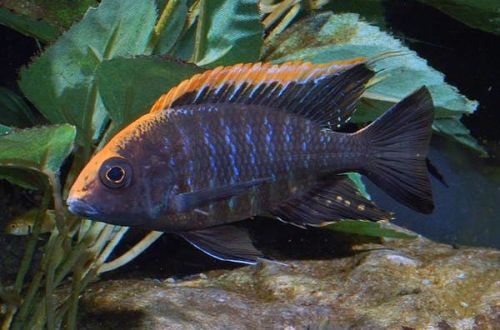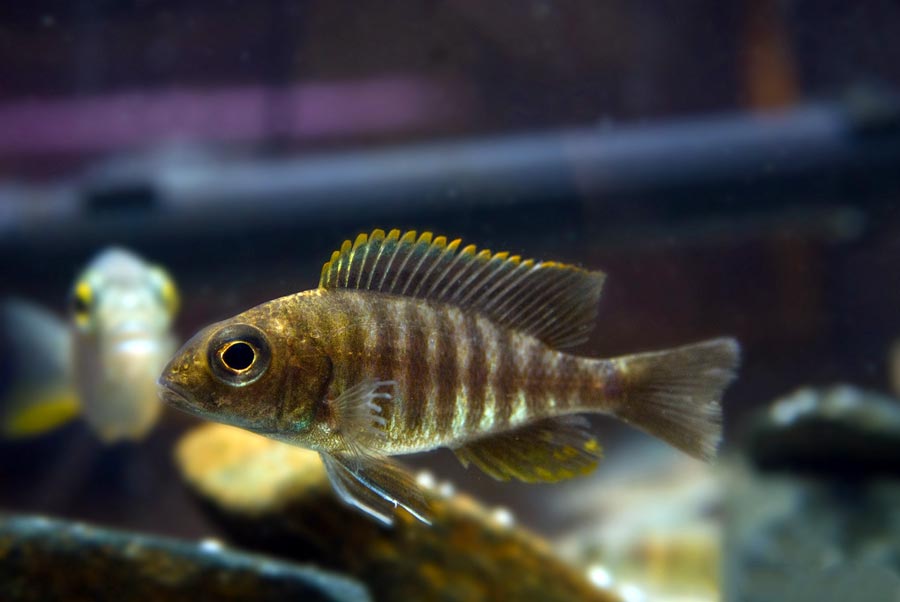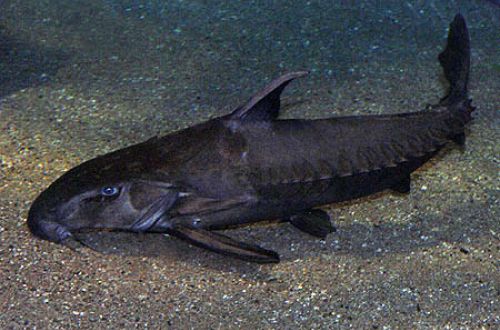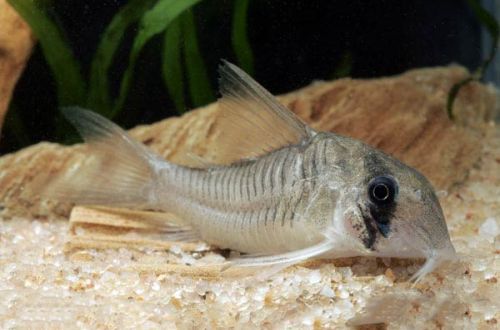
Aulonokara leans
Aulonocara maylandi, scientific name Aulonocara maylandi, belongs to the Cichlidae family. A typical representative of the Malawian cichlids. Relatively easy to keep and breed. Compatible with many other fish capable of living in similar conditions.

Contents
Habitat
Endemic to Lake Malawi in East Africa. There are two color forms of this species. The first lives in the southeastern part of the lake, the second near the tiny island of Kande (Kande Island) on the west coast. They inhabit the coastal zone, preferring regions with a sandy bottom and interspersed rock heaps.
Brief information:
- The volume of the aquarium – from 100 liters.
- Temperature – 25-29°C
- Value pH — 7.4–9.0
- Water hardness – 10–27 GH
- Substrate type – sandy
- Lighting – moderate
- Brackish water – no
- Water movement is weak
- The size of the fish is 8–10 cm.
- Food – small sinking food from a variety of products
- Temperament – conditionally peaceful
- Keeping in a harem with one male and several females
Description

Adults reach a length of 8–10 cm. As noted above, Aulonokara mylanda has two subspecies. The fish near Kande Island have a rich dark color with a contrasting white stripe stretching from the tip of the head to the beginning of the dorsal fin. Males and females are practically indistinguishable. The second subspecies from the southwestern part of the lake has a similar coloration, only the stripe has a rich yellow color and continues along the entire edge of the fin. So the coloration is characteristic of the male, the females look more modest with a predominance of gray-brown colors, and the body pattern consists of rows of light and dark stripes.
Food
They feed at the bottom, sifting sand with their mouths in search of food, mainly phyto- and zooplankton. In a home aquarium, sinking foods should be fed that combine vegetable and protein components. The diet may consist of dry flakes, granules with frozen daphnia, brine shrimp, bloodworm pieces.
Maintenance and care, arrangement of the aquarium
The optimal size of the aquarium for a group of 3-4 fish starts from 100 liters. The design uses heaps of stones and sandy soil. The substrate should not contain large and abrasive particles that can get stuck or damage the mouth of the fish during feeding. Rooting plants are not recommended as they will be quickly dug up.
The main task in keeping Aulonocara Maylanda is to ensure stable water conditions with suitable hydrochemical parameters and temperature conditions. The following aquarium care procedures are mandatory: weekly replacement of part of the water with fresh water (30–50% of the volume), regular removal of organic waste, equipment maintenance and monitoring of the main water parameters (pH and dGH). Also, do not forget to check the water for the presence of dangerous concentrations of products of the nitrogen cycle (ammonia, nitrites, nitrates).
The filtration system is of great importance in maintaining biological balance. When choosing a specific model, it must be taken into account that the filter will have to cope with severe clogging, especially if water is taken in the bottom layer. The reason is the same – the peculiarity of fish nutrition. When they sift through the sand, a cloud of suspended matter forms, inevitably entering the filtration system.
Behavior and Compatibility
Males compete with each other for territory and females, so in a small aquarium it is desirable to maintain a harem-type model – one male and several females. Compatible with other non-territorial fish species of comparable size, preferably from Lake Malawi or Tanganyika. Overly active neighbors such as Mbuna cichlids should be avoided.
Breeding / breeding
The breeding strategy of Malawian cichlids and the Aulonokara maylanda in particular differs from that of most freshwater fish. Instead of laying, fertilized eggs end up in the female’s mouth, which she wears throughout the entire incubation period. The fry that have appeared for some time continue to hide in the mouth in case of danger, until they become too large. Such a mechanism for the protection of offspring has evolved in a very competitive environment, where other methods were ineffective.
In favorable conditions, spawning occurs regularly. With the onset of the breeding season, males begin to actively pursue females – this is part of the mating courtship, which from the outside seems quite aggressive. It is desirable to maintain such a group size where there will be several females per male. In a one-on-one situation, the female may suffer from excessive “attention to herself.” It is also worth remembering that in the presence of other males and a lack of space for skirmishes, sometimes fierce, between them cannot be avoided.
Fish lay several dozen eggs. The fry appear within four weeks. They grow quickly, by the age of 4 months they themselves can give birth.
Fish diseases
The main cause of diseases lies in the conditions of detention, if they go beyond the permissible range, then immunity suppression inevitably occurs and the fish becomes susceptible to various infections that are inevitably present in the environment. If the first suspicions arise that the fish is sick, the first step is to check the water parameters and the presence of dangerous concentrations of nitrogen cycle products. Restoration of normal/suitable conditions often promotes healing. However, in some cases, medical treatment is indispensable. Read more about symptoms and treatments in the Aquarium Fish Diseases section.





